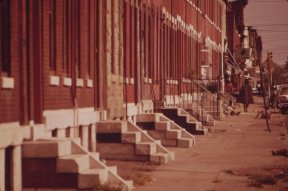
 Y PARISH is in a neighborhood called Parkwood Manor. Most of the folks in our parish at some point moved to this neighborhood from another Philadelphia neighborhood. Some of them have roots in Kensington & Fishtown, others in West Oak Lane or South Philly. Many of them moved here as young couples in the 1960’s, and others have moved in more recently.
Y PARISH is in a neighborhood called Parkwood Manor. Most of the folks in our parish at some point moved to this neighborhood from another Philadelphia neighborhood. Some of them have roots in Kensington & Fishtown, others in West Oak Lane or South Philly. Many of them moved here as young couples in the 1960’s, and others have moved in more recently.
No matter where you are from, if you have ever relocated, you know that it can be quite a difficult experience to go back. It can be an eye-opening venture when you take a drive through “the old neighborhood.” Things change after we have moved on, and, when we go back, rarely do we ever think they have changed for the better. The new owners may have painted over the woodwork or put up a new fence or let some part of the house fall into disrepair. It can be hard to observe the changes to a place we once loved. I remember my parents taking our family once on a drive by the house we lived in when I was very young. I hardly remembered the house, myself, but I’ll never forget how my dad went on a tirade about how the new owner had let the bushes in front of the house grow wild.
Perhaps this was the reason for the Assumption. Jesus spent his earliest days in Mary’s womb; He went on to spend 30 years at her side; she was there when He died. Perhaps Jesus couldn’t bear to allow His Mother’s body to decay, like all of ours will some day. She is the Immaculate Conception, after all, so we ought not to be indignant that she would receive special treatment. All of us are sinners, and the “wages of sin” are death and decay. But Mary was sinless from the first moment of her conception. Just as our Lord preserved her from the stain of sin before her conception, we believe that He preserved her from the stain of decay after her death. Instead, He chose to bring her, body & soul, to heaven. This we call the Assumption.
It can be hard to go back to the neighborhood where we grew up. Ultimately, though, the place we really come from isn’t a neighborhood, but the heart of God, Himself. On this feast of the Assumption, Mary shows us the way back home. Where our Blessed Mother has gone, we hope to follow!
